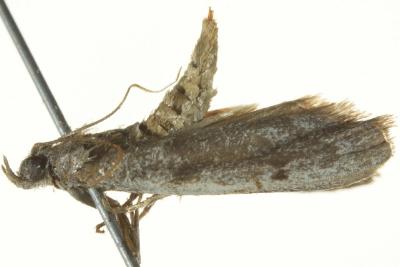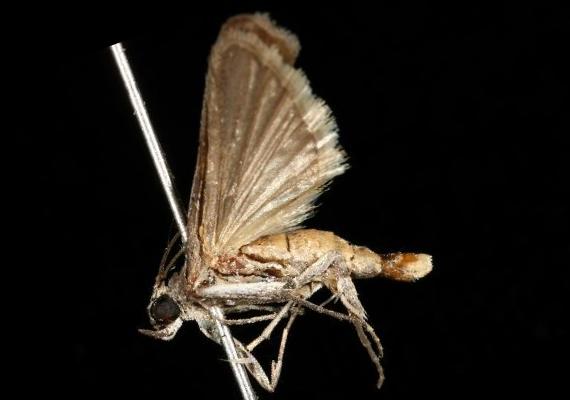
| Senecio Blue Stem-borer (formerly known as Homoeosoma farinaria) PHYCITINAE, PYRALIDAE, PYRALOIDEA | (donherbisonevans@yahoo.com) and Stella Crossley |

(Photo: courtesy of Dianne Clarke, Kuratau, New Zealand)

| Senecio Blue Stem-borer (formerly known as Homoeosoma farinaria) PHYCITINAE, PYRALIDAE, PYRALOIDEA | (donherbisonevans@yahoo.com) and Stella Crossley |

(Photo: courtesy of Dianne Clarke, Kuratau, New Zealand)
The Caterpillar of this species bores into the stems of plants in ASTERACEAE, such as
The caterpillars are stout and bluish-brown, with a dark head and collar, and vague stripes along the body.

The caterpillars bore into the stems, leaving a mess of silk, old skins, and frass at the borehole.

This adult moth has flour-coloured forewings, each with dark speckles, a ragged dark band across the middle, and another across the margin. The hindwings are plain pale grey. The abdomen is the colour of flour. The moth has a wingspan of about 3 cms.

This species occurs in
as well as in Australia in

Further reading:
Peter B. McQuillan & J. E. Ireson,
The identity and immature stages of Patacoiodes farinaria (Turner) comb. n.
(Lepidoptera: Pyralidae: Phycitinae) in Australia and New Zealand,
Australian Journal of Entomology,
Volume 26, Issue 3, pp. 239-241.
A. Jefferis Turner,
A preliminary revision of the Australian Thyrididae & Pyralidae. Part I,
Proceedings of the Royal Society of Queensland,
Volume 18 (1904), p. 126, No. 43.
 caterpillar |  butterflies |  Lepidoptera |  moths |  caterpillar |
(written 30 March 2019)